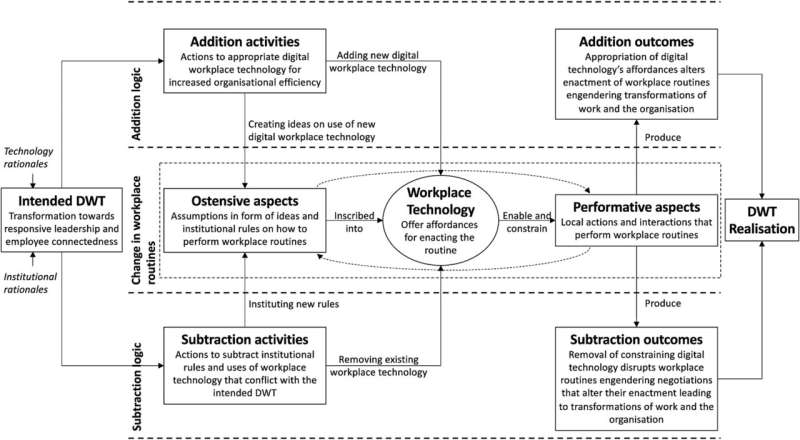Decoding the path to digital workplace transformation

New research from Copenhagen Business School, along with Leuphana University and University of Turku sheds light on the importance of subtracting as much as adding in the journey of digital workplace transformation.
The research focused on one of the world’s oldest car manufacturers who employs more than 200,000 employees worldwide and who launched its digital workplace transformation strategy in 2016.
“The subtraction logic, that is, the process of removing obstructive routines and technologies, is often disregarded in digital workplace transformation, despite being equally crucial,” says co-author and Associate Professor Abayomi Baiyere at the department of digitalization, Copenhagen Business School.
The findings highlight two approaches to a successful digital transformation: the addition logic of incorporating new technology and the subtraction logic of eliminating old technology that sustains unwanted practices. By emphasizing the need for subtraction logic alongside addition logic, the research unveils a critical aspect often neglected in digital workplace transformation.
“By recognizing the value of subtraction logic and not taking a one-sided focus on just the addition logic, organizations can foster innovation, adaptation, and employee empowerment,” adds Associate Professor Abayomi Baiyere.
The paper was recently published in the Journal of Strategic Information Systems.
Subtraction logic
Subtraction logic as deinstitutionalisation refers to the process of removing established practices to make way for new ideas and approaches, enabling innovation and adaptation within an organization or society. It involves challenging traditional norms, rules, and behaviors to embrace change and new technologies.
“Subtraction in digital transformation requires careful consideration of which established practices need to be abandoned to achieve transformation goals. Organizations like the car company aiming for employee empowerment need to remove practices that oppose or undermine this notion, such as excessive managerial approvals,” adds co-author Dr. Markus Zimmer from Leuphana University of Luneburg, Germany.
The paper discusses how the car company rejected existing approval rules that caused delays in decision-making. Besides rejecting existing rules, the company also removed its business travel system, which enforced formal approval for trips. This change was viewed as a way to empower employees rather than restrict them. Initially, some managers resisted the change by insisting on approval via email, but the removal of the system helped establish new approval processes.
Similarly, hierarchy had a significant impact on the allocation of IT equipment, which served as status symbols tied to one’s position. However, the car company challenged this norm by eliminating permission rights to the IT ordering system. This change enabled employees to independently order IT equipment that aligned with their actual job needs, rather than their hierarchical position.
Although some managers questioned how employees could afford expensive smartphones, the new IT ordering system empowered employees to embrace the revised rules and push the boundaries
“These conflicts occur because some individuals are reluctant to let go of privileges and control associated with the old practices,” adds Zimmer.
The research advocates for embracing the dual process of adding new elements while simultaneously subtracting unwanted ones and urges organizations to contemplate not only their desired future but also the aspects they wish to leave behind from the past.
“Our hope is that organizations use our research to approach digital workplace transformation not only by incorporating new practices and new technologies but also by eliminating those that impede their transformation goals. Taking such a balanced view may help managers avoid frustrations caused by the dominant ‘addition narrative’ logic,” concludes Baiyere.
More information:
Markus Philipp Zimmer et al, Digital workplace transformation: Subtraction logic as deinstitutionalising the taken-for-granted, The Journal of Strategic Information Systems (2023). DOI: 10.1016/j.jsis.2023.101757
Provided by
Copenhagen Business School
Citation:
Decoding the path to digital workplace transformation (2023, May 25)
retrieved 25 May 2023
from https://phys.org/news/2023-05-decoding-path-digital-workplace.html
This document is subject to copyright. Apart from any fair dealing for the purpose of private study or research, no
part may be reproduced without the written permission. The content is provided for information purposes only.
For all the latest Science News Click Here
For the latest news and updates, follow us on Google News.

